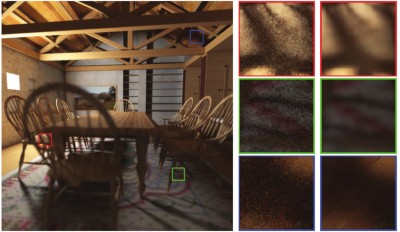Recent Advances in Adaptive Sampling and Reconstruction for Monte Carlo Rendering
In this paper, we survey recent advances in this area. We distinguish between “a priori” methods that analyze the light transport equations and derive sampling rates and reconstruction filters from this analysis, and “a posteriori” methods that apply statistical techniques to sets of samples to drive the adaptive sampling and reconstruction process.
May 8, 2015
Eurographics 2015
Authors
Matthias Zwicker (University of Bern)
Wojciech Jarosz (Disney Research)
Jaakko Lehtinen (Aalto University)
Bochang Moon (Korea Advanced Institute of Science and Technology)
Ravi Ramamoorthi (University of California, San Diego)
Fabrice Rousselle (Disney Research)
Pradeep Sen (University of California, Santa Barbara)
Cyril Soler (Inria Grenoble Rhone-Alpes)
Sung-Eui Yoon (Korea Advanced Institute of Science and Technology)
Monte Carlo integration is firmly established as the basis for most practical, realistic image synthesis algorithms because of its flexibility and generality. However, the visual quality of rendered images often suffers from estimator variance, which appears as visually distracting noise. Adaptive sampling and reconstruction algorithms reduce variance by controlling the sampling density and aggregating samples in a reconstruction step, possibly over large image regions. In this paper, we survey recent advances in this area. We distinguish between “a priori” methods that analyze the light transport equations and derive sampling rates and reconstruction filters from this analysis, and “a posteriori” methods that apply statistical techniques to sets of samples to drive the adaptive sampling and reconstruction process. They typically estimate the errors of several reconstruction filters and select the best filter locally to minimize error. We discuss advantages and disadvantages of recent state-of-the-art techniques and provide visual and quantitative comparisons. Some of these techniques are proving useful in real-world applications, and we aim to provide an overview for practitioners and researchers to assess these approaches. In addition, we discuss directions for potential further improvements.

